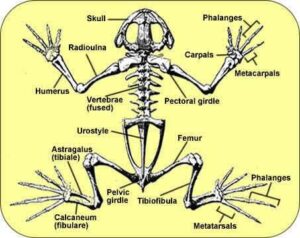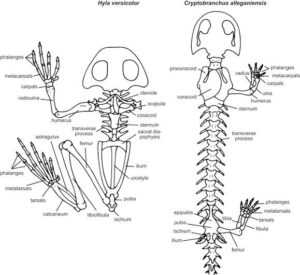Back to: ZOOLOGY 300 Level
WELCOME TO CLASS!
You’re doing great! I’m really glad to see you show up ready to learn. Today, we’re looking at something very special—how three important parts of the vertebrate body have changed over time: the vertebral column, skull, and brain. These are the parts that make vertebrates stand out and succeed in almost every part of the world—from the deepest oceans to the highest mountains, even right here in Nigeria.
Evolution Of Vertebral Column, Skull, And Brain
These structures didn’t just appear overnight. Over millions of years, they evolved, adapted, and improved to help animals move better, think smarter, and survive longer. Understanding this evolution helps us see the powerful journey from simple fish to complex mammals—including us humans!

Evolution of the Vertebral Column
Let’s begin with the vertebral column, also known as the backbone. In the earliest chordates, like lancelets, there was no true backbone—just a flexible rod called a notochord. This notochord was enough to provide support for slow, simple animals. But as creatures began to move more and grow larger, they needed something stronger.
So, evolution responded. Over time, the notochord was replaced by a series of small bones called vertebrae. These bones could protect the spinal cord, support more weight, and allow for better movement. Imagine the difference between a flexible straw and a stack of LEGO blocks—you can bend the straw, but the blocks give more strength and control. This is how the vertebral column helped animals swim faster, walk on land, and even fly!
As vertebrates moved from water to land, their backbones also changed. They developed specialised regions—cervical (neck), thoracic (chest), lumbar (back), sacral (pelvic), and caudal (tail)—to handle different tasks. For example, in mammals like goats or lions, the backbone helps them balance, run, and jump.
Evolution of the Skull
The skull, or cranium, is another amazing development in vertebrates. In early animals, the head was soft and not well-protected. But as brains and sensory organs (eyes, nose, ears) became more advanced, nature built a protective casing to keep them safe. That casing is the skull.
The earliest skulls were made of cartilage, like what you feel in your nose or ears. Over time, many vertebrates evolved bony skulls. These were stronger and more protective. Just imagine playing football with a soft head—that wouldn’t go well! The skull also helped hold the jaw, which made feeding more powerful and efficient.

As vertebrates continued to evolve, their skulls became more complex. Birds have lightweight skulls for flight, while crocodiles have long, strong skulls for catching prey. In humans, the skull holds a large brain and even leaves space for facial expressions!
Evolution of the Brain
Now to the most exciting part—the brain. In simple animals, the brain was just a small nerve cluster. But in vertebrates, it became a central command system.
As early fish evolved, their brains developed special regions to control vision, smell, movement, and balance. When animals moved onto land, their brains needed to handle more tasks—like processing sound, thinking ahead, and remembering food locations. That’s when parts like the cerebrum and cerebellum grew larger.
The more complex an animal’s life, the more complex its brain became. Mammals, especially primates and humans, have highly developed brains for learning, solving problems, and even feeling emotions. That’s why you can read this note, solve a Zoology question, and still remember your friend’s birthday—all thanks to your evolved brain!
Summary
- The vertebral column evolved from a notochord into segmented bones (vertebrae) for better support and movement.
- The skull developed to protect the brain and sensory organs, becoming more complex over time.
- The brain evolved from simple nerve clusters into a powerful organ capable of learning, memory, and coordination.
- These changes helped vertebrates become faster, smarter, and more adaptable.
Evaluation
- What is the main difference between a notochord and a vertebral column?
- How did the skull benefit early vertebrates?
- Why is the evolution of the brain important in vertebrate success?
- Mention two changes that happened in the vertebral column as vertebrates moved to land.
- Give one example of how skull shape relates to function in animals.
You’ve just learnt how your backbone, skull, and brain connect you to millions of years of evolutionary success. Keep holding your head up—you’re walking proof of how powerful and amazing vertebrates have become. Let’s continue building your understanding with even more exciting topics ahead!
